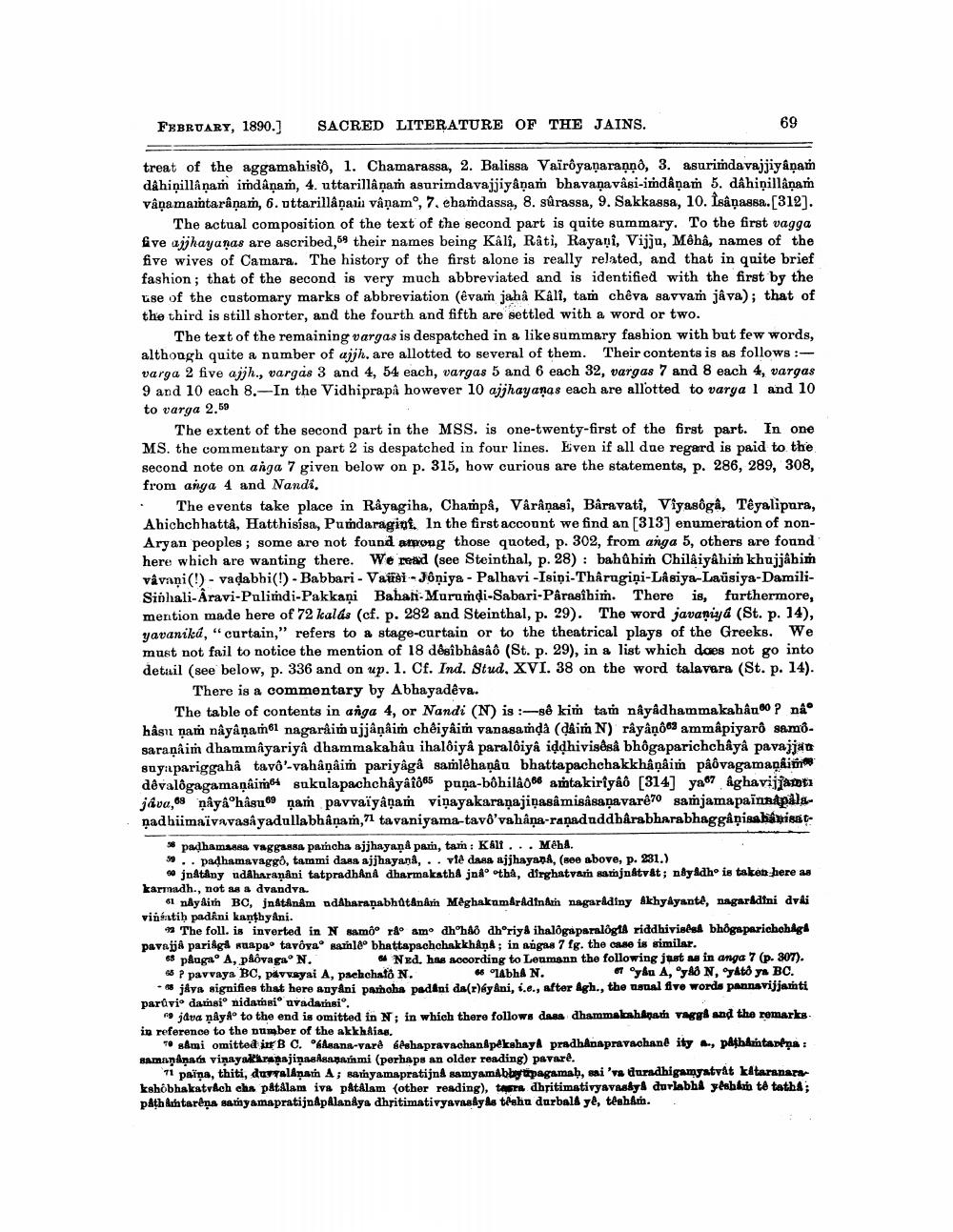________________
FEBRUARY, 1890.)
SACRED LITERATURE OF THE JAINS.
69
treat of the aggamahisio, 1. Chamarassa, 2. Balissa Vaïrôyanaraņņð, 3. asurimdavajjiyaņań dahiņillâņam irdâņam, 4. uttarillâ nan asurimdavajjiyâņam bhavanavasi-indanar 5. dAhiņillanań vâņamaintarâņam, 6. uttarillåna i våņamo, 7. ebamdassa, 8. sûrassa, 9. Sakkassa, 10. Isaņassa. [312).
The actual composition of the text of the second part is quite summary. To the first vagga five ajhayanas are ascribed, 58 their names being Kâlî, Râti, Rayani, Vijju, Môhâ, names of the five wives of Camara. The history of the first alone is really related, and that in quite brief fashion; that of the second is very much abbreviated and is identified with the first by the use of the customary marks of abbreviation (évam jaha Kali, tam chêva savvam jâva); that of the third is still shorter, and the fourth and fifth are settled with a word or two.
The text of the remaining vargas is despatched in a like summary fashion with but few words, althongh quite a number of ajjh, are allotted to several of them. Their contents is as follows: varga 2 five ajjh., vargas 3 and 4, 54 each, vargas 5 and 6 each 32, vargas 7 and 8 each 4, vargas 9 and 10 each 8.-In the Vidhiprapå however 10 ajjhayanas each are allotted to varya 1 and 10 to varga 2.59
The extent of the second part in the MSS. is one-twenty-first of the first part. In one MS. the commentary on part 2 is despatched in four lines. Even if all due regard is paid to the second note on anga 7 given below on p. 315, how curious are the statements, p. 286, 289, 308, from anga 4 and Nandi. · The events take place in Rayagiha, Champa, Vårânasi, Baravati, Viyasôga, Têyalipura, Ahichchhattå, Hatthisisa, Pumdaragint. In the first account we find an [313] enumeration of nonAryan peoples; some are not found among those quoted, p. 302, from anga 5, others are found here which are wanting there. We mad (see Steinthal, p. 28) : bahûhim Chilâiyâhim khujjahin vâvaņi(!) - vadabbi(!) - Babbari - Vaüst - Fôniya - Palhavi -Isiņi-Thârugiņi-LÀsiya-Laüsiya-DamiliSinhali-Aravi-Pulimdi-Pakkaņi Baban-Murundi-Sabari-Pârasihim. There is, furthermore, mention made here of 72 kalás (cf. p. 282 and Steinthal, p. 29). The word javaniya (St. p. 14), yavaniká, "curtain," refers to a stage-curtain or to the theatrical plays of the Greeks. We must not fail to notice the mention of 18 dêsîbhâsâð (St. p. 29), in a list which does not go into detail (see below, p. 336 and on up. 1. Cf. Ind. Stud. XVI. 38 on the word talavara (St. p. 14).
There is a commentary by Abhayadêva.
The table of contents in anga 4, or Nandi (N) is :-sê kim tan niyadhammakahâu ? nao hâsu nam nâyâņam61 nagaraiń ujjáņaiṁ chêiyâim vanasamạå (dáim N) râyâņô63 ammâpiyarô samosaranâim dhammiyariya dhammakahâu ihalõiyâ paralõiya iddhivisðsa bhôgaparichchåyå pavajjad snya pariggahả tavo'-vahânâim pariyâgå samlêhaņâu bhattapachchakkhâņain pâôvagamankim dêvalôgagamankiri sukulapachchâyâso65 puņa-bôhila 66 amtakirîyâð [314] ya67 Agha vijjanti java, 68 mâyâ hâsu nam pavvaïyâņam viņayakaraṇajiņaså misâsanavarér samjamapainatpålanadhiimaïvnvasîyadullabhânań,71 tavaniyama-tavô vahâņa-raņaduddhârabharabhaggâộisabánisat
padhamana vaggana pancha ajjhayaņå parin, tam: Kált... Meh. ".. padhamsvaggð, tammi dans ajjhayana, .. vie dans ajjhayapA, (see above, p. 231.)
" jnAtany udAharanani tatpradhana dharmakatha jnào otha, dirghatvah samjnktvet; ndyldho is taken here as karmadh., not as a dvandva.
1 ndydir BC, jnftanám adAharaṇabhdtånám MeghakamsrAdin&rin nagaradiny Akhylyante, nagarddini dvài vintatib padini kanthyAni.
The foll. is inverted in N samo r&amo dh'hảo dhoriya ihaloga paralógta riddhivis sa bhôgaparichohag pavajja pariaga kuapao tavovao sannleo bhattapachchakkháng; in angas 7 fg. the case is similar. 68 plagao A, plovagnon.
Nxd, has according to Leumann the following just win anga 7 (p. 307). P pavvays BC, pilvvayni A, prehchato N.
1AbhA N.
Syka A, AO N yato ya BC. • jaya signifies that here anyAni pamoha padini de(r)byAni, i.e., after Agh., the usual five words pannavijjanti parūvio damaio nidarsio uvadarnsio.
19 java ņdyAo to the end is omitted in N; in which there follows dass dhamma hapat vaggl and the remarks in reference to the number of the akkhliag.
smi omitted in B C. "Anana-varê bêshapravachanapékshayA pradh napravachand ity m., pathlintapena: BamApkņada viņayakranajiņasAsadami (perhaps an older reading) pavare.
11 paina, thiti, duvralamah A; whyamapratijns samyamábbytipagamab, si'va duradhigamyatvat kitaranara kshobhakatsheh cha patalam ivs pAtAlam (other reading), tara dhritimativyavas y durlabha yubkb to tathA; path Athtarēņa satyamapratijnApklandya dhritimativyavas yks tahu durball ye, tenho.




